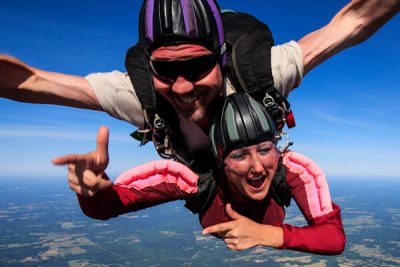Skydiving for the first time is an experience that comes with a wide range of emotions – excitement, exhilaration, stress, and even fear. But understanding skydiving statistics and how they relate to skydiving safety before you jump can help you manage some of those emotions and have a more enjoyable experience.
The skydiving success rate is a lot higher than you probably think, and comparing those statistics to everyday activities might just surprise you. Let’s dig into the numbers, talk about calculated risk, and answer the question: how statistically safe is skydiving?
Skydiving Participation Numbers
 The first set of numbers that are useful to talk about are the participation stats. All statistics related to the success of skydiving are calculated by considering the number of people who take part in the sport. These numbers are recorded and analyzed by the USPA (United States Parachute Association), which is the governing body for the sport in the US.
The first set of numbers that are useful to talk about are the participation stats. All statistics related to the success of skydiving are calculated by considering the number of people who take part in the sport. These numbers are recorded and analyzed by the USPA (United States Parachute Association), which is the governing body for the sport in the US.
So, what percentage of the population goes skydiving? Around 500,000 people, or 0.15% of the overall US population, make a tandem skydive every year! No surprise that percentage gets exponentially smaller when we consider the people who go on to get their skydiving license and jump as an ongoing hobby. Only 41,000 people, or 0.012% of the population, hold an official skydiving license.
In 2024, there were a total of 3.88 million skydives made at USPA dropzones. As you’ll see in the next section, this jump number far outweighs the number of skydiving fatalities that occur in any given year.
Skydiving Safety Statistics
Depending on whether you’re a glass-half-full or a glass-half-empty person, you probably got to this article by wondering one of two questions: “What is the success rate of skydiving?” or “What is the accident rate of skydiving?” Either way, this can be answered by considering the annual jump numbers.
Here are the numbers associated with the last five years of skydives made by experienced jumpers as reported by the USPA for 2024:
| Year | Skydiving Fatalities in the US | Estimated Annual Jumps | Fatalities per 100,000 Jumps |
| 2024 | 9 | 3.88 million | 0.23 |
| 2023 | 10 | 3.65 million | 0.27 |
| 2022 | 20 | 3.9 million | 0.51 |
| 2021 | 10 | 3.57 million | 0.28 |
| 2020 | 11 | 2.8 million | 0.39 |
Every skydiving fatality is a blow to the community, and we are grateful to the major advancements in our extreme sport that have helped to decrease the number of fatalities each year. Every skydiver knows the risks associated with jumping out of a plane from a few miles up. (Understanding these risks is part of the reason why you must be 18 years old to make a jump.)
Let’s look at more minor injuries, too. In 2024, 5.6% of experienced skydivers reported that they experienced an injury that required medical treatment. The most common injury is ankle-related from landings.
Record-Breaking Skydiving Statistics
Breaking records is always fun, but it’s never more important than when it comes to safety. Skydiving has many opportunities to break records in different areas of the sport – largest formations, fastest speeds, farthest flights, even naked skydives – but we take our safety records the most seriously.
An important record was set in 2024 when there were nine skydiving fatalities in the United States; a record low since record-keeping began in 1961. To put that number into perspective, that’s 0.23 fatalities per 100,000 jumps, or 1 in 434,783.
That’s thanks to a variety of reasons, but mostly research, development, and an emphasis on safety culture. Our gear is the most advanced it’s ever been, our student programs are the most comprehensive to date, and our emphasis on risk awareness and mitigation is unrelenting. The best part about skydiving is landing safely to do it again!
Skydiving Statistics: In Context
 These numbers are all well and good, but they don’t mean much without some sort of context.
These numbers are all well and good, but they don’t mean much without some sort of context.
One way to wrap our heads around fatality statistics is to compare them with activities a lot of us do every day. These numbers aren’t exactly apples-to-apples, but they do give us an idea of how skydiving measures up:
- The lifetime odds of dying in a car accident in the US are about 1 in 93.
- The lifetime odds of dying in an accidental fall are about 1 in 98.
- The lifetime odds of dying from drowning are about 1 in 1,100.
So, is skydiving safer than driving? We would never say that skydiving is “safe” – it’s not. You are jumping out of an airplane, after all! But considering the safety statistics of mundane activities is certainly an interesting exercise.
Fun & Surprising Skydiving Facts
Not all skydiving statistics have to be foreboding – after all, jumping out of an airplane is primarily about having fun! Let’s take a look at some of the more quirky, impressive, and downright incredible facts related to jumping out of airplanes:
- Highest skydive: 135,889 feet
- Fasted skydive: 329.18 mph
- Oldest skydiver: 106 years and 327 days
- Largest naked skydive: 26 naked people
- First skydive ever made: October 22, 1797
Feel informed and ready to jump out of an airplane? Book a tandem today! Blue skies!
Copyright © 2025, Skydive Monroe, All Rights Reserved.
DropZone Web Design & Marketing by Beyond Marketing, LLC



